Do you think that deleting or hiding text in a PDF means it's completely gone? If so, remember that even after you remove content, hidden data like metadata, comments, or document history still remain beneath the surface. This means that sensitive information such as personal details, contract terms, or internal notes could be recovered by someone with the right tools.
For this, sanitize PDF is the right technique, which means you're wiping out all hidden data to make sure nothing confidential remains accessible. To do so, there are different methods which will be discussed in the article as follows. You can also download UPDF, a comprehensive PDF editor with a Sanitize PDF feature.
Windows • macOS • iOS • Android 100% secure
Part 1. What Does It Mean to Sanitize a PDF?
As discussed above, sanitizing means thoroughly removing all hidden data and sensitive information from the document to prevent accidental exposure. This process guarantees that the PDF is completely clear of any background information while making it easier to share without the risk of leaking details. It's specifically vital when handling confidential or sensitive documents such as legal contracts or personal information.
Sanitize PDF is more complicated than simply removing information because it goes further by eliminating content that might not be visible at first glance. Proper sanitization helps comply with privacy regulations and data protection standards, assuring confidential information remains intact. Thus, a trustworthy tool is essential for complete data protection that gives you peace of mind when sharing or storing important documents.
Part 2. 4 Methods to Sanitize a PDF
Explore this section, packed with several methods that you can use to sanitize PDFs to prevent unintended information leaks:
1. Using UPDF
The Sanitize PDF feature by UPDF allows users to remove all the hidden data and metadata from their documents. This means sensitive information is not passed along when you publish the PDF.
- To use this, you need to download UPDF by clicking the button below. Open the PDF in UPDF and go to "Tools" > "Redact."
Windows • macOS • iOS • Android 100% secure
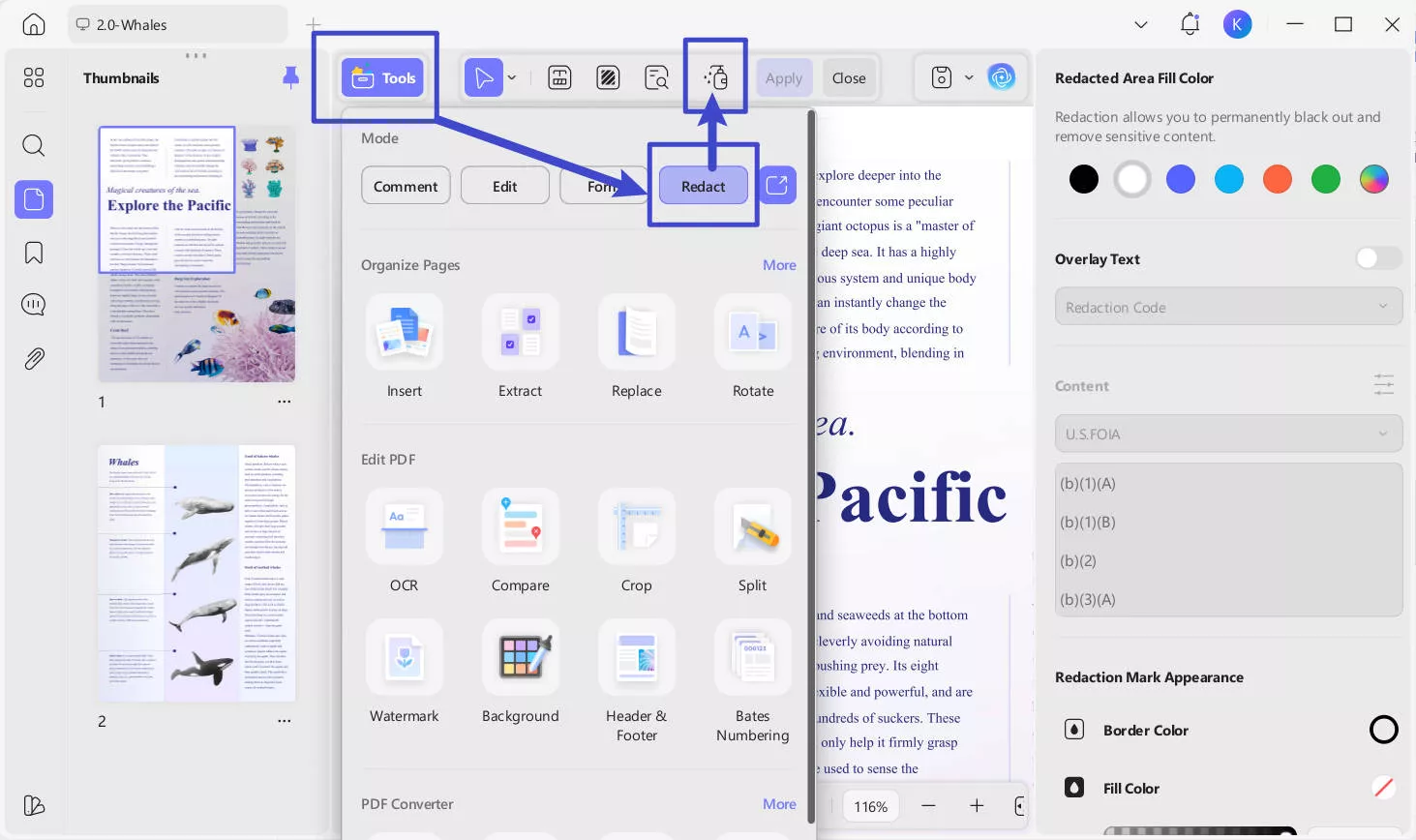
- Click "Sanitize Document" from the top toolbar. In the new window, read the list for things that will be remove.
Here’s a breakdown of each item listed:
- Metadata – Information about the document like author, creation date, software used, and modification history.
- Embedded content and attached files – Any files or media included inside the PDF (like images, links, or other documents).
- Scripts – Code embedded in the PDF (usually JavaScript) that could run automatically.
- Hidden layers – Layers in the PDF that are not visible when viewing but still exist in the file.
- Embedded search index – Data that helps the PDF’s search function work faster.
- Stored form data – Information entered into forms within the PDF.
- Review and comment data – Notes, highlights, or annotations made by reviewers.
- Hidden data from previous document saves – Old or overwritten content that may still exist in the file.
- Obscured text and images – Text or images that are hidden behind objects or made invisible.
- Comments hidden within the body of the PDF file – Annotations that are not directly visible.
- Unreferenced data – Data in the file that isn’t actively used or linked.
- Links, actions, and JavaScript – Hyperlinks, interactive actions, or scripts that can trigger behavior.
- Overlapping objects – Layers or objects that overlap and may contain hidden content.
- Click on the OK button to continue. Following this, you’ll be allowed to save your PDF with sensitive information removed.
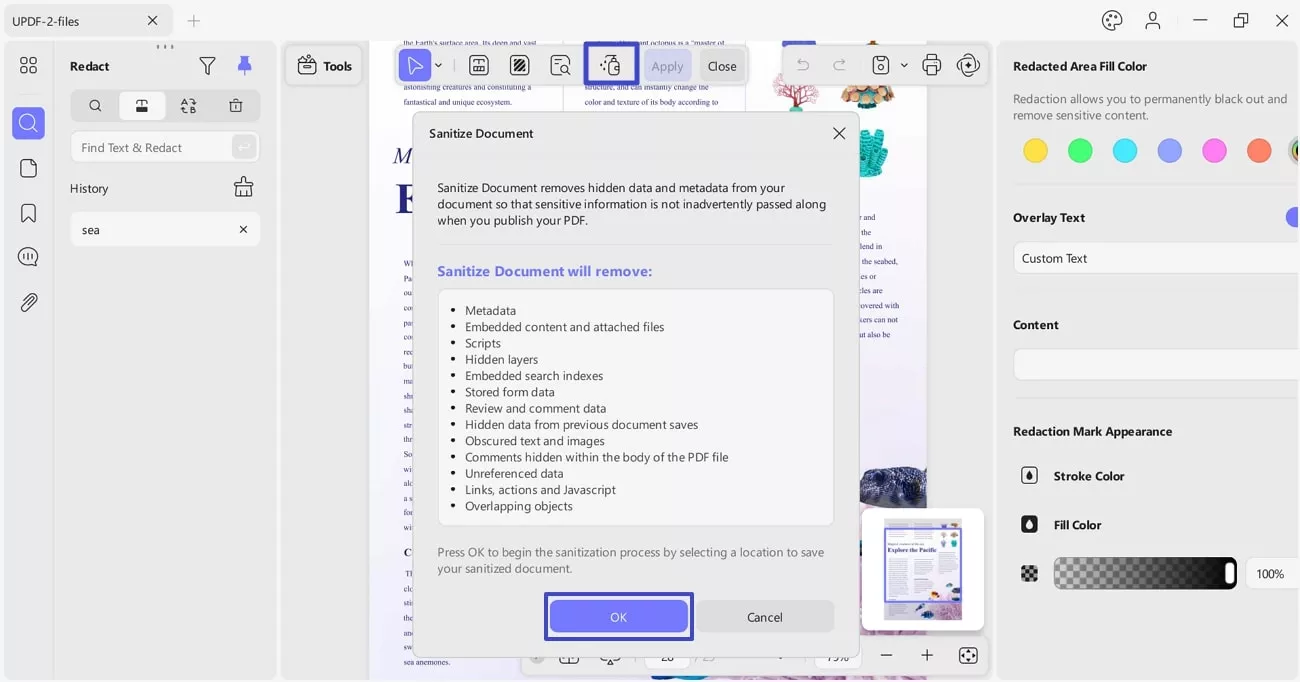
Let’s compare before and after. I now have a file with a sticker and picture added, and some of my doodles.
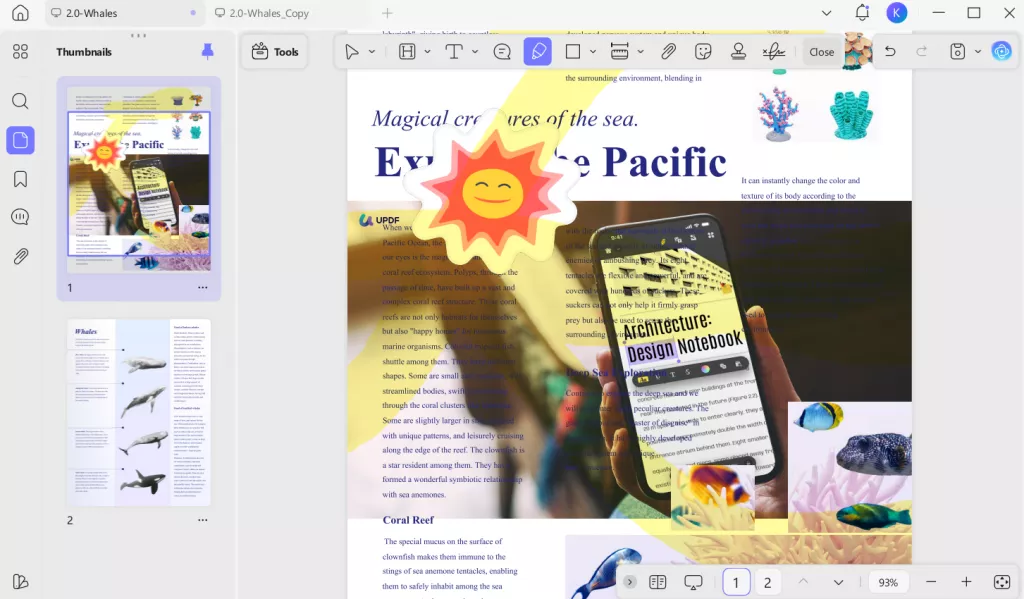
After sanitizing, the file became very clean and restored to the way it was before I made the changes.
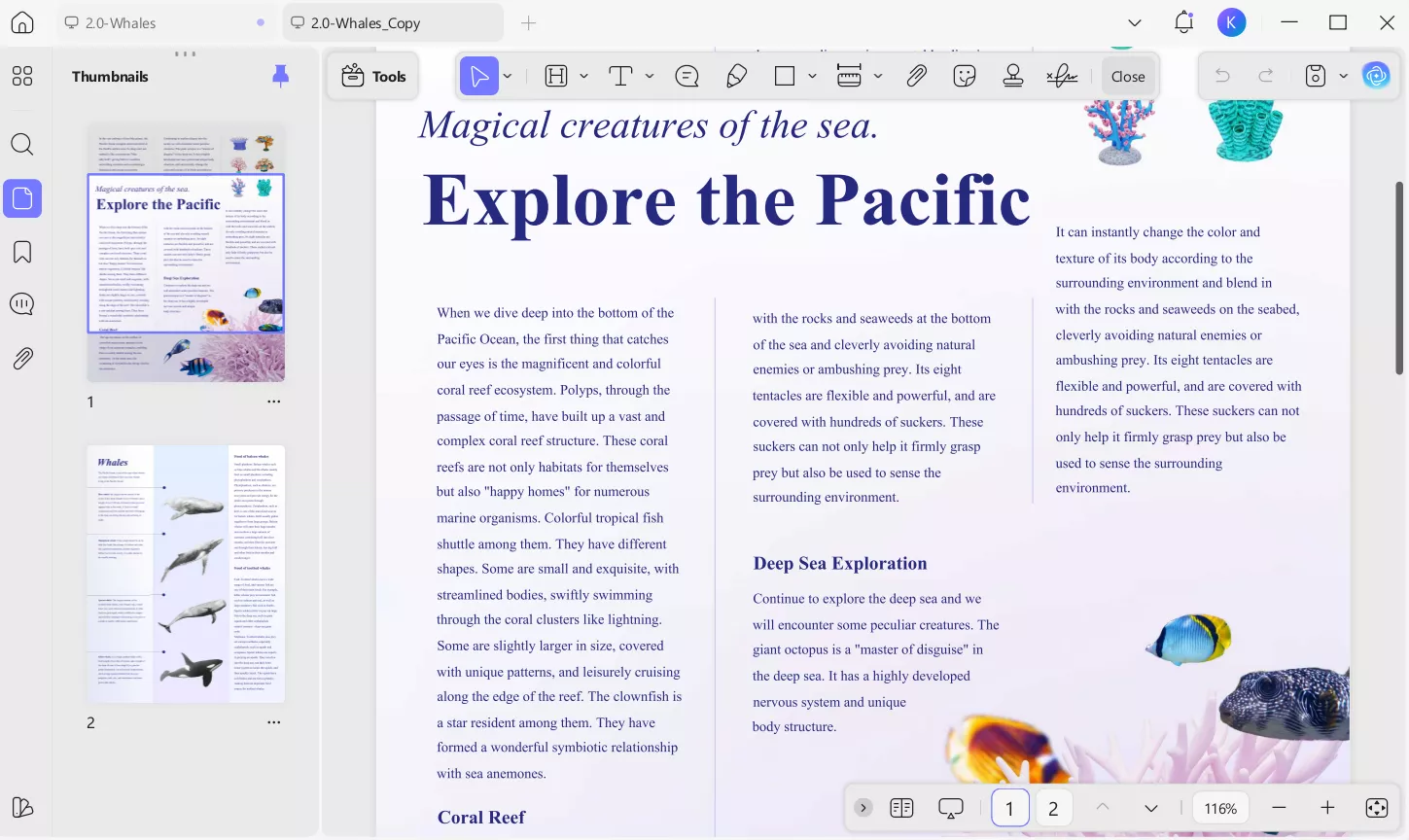
Watch the video tutorial below to know more ways about protecting PDF:
2. Using Adobe Acrobat
This versatile tool provides a built-in sanitization feature that allows users to eliminate hidden data from a PDF. Using its redact and sanitize feature, you can modify the appearance of your reductions with different colors or text overlays. Once the information is redacted, it allows to sanitize PDF by selectively removing hidden information. Adhere to the guide and hide selected or entire content with Adobe Acrobat:
Step 1. Launch Adobe Acrobat on your device and access the "All Tools" > "Redact a PDF".
Step 2. With the Redact toolset open on the left pane, select "Sanitize document".
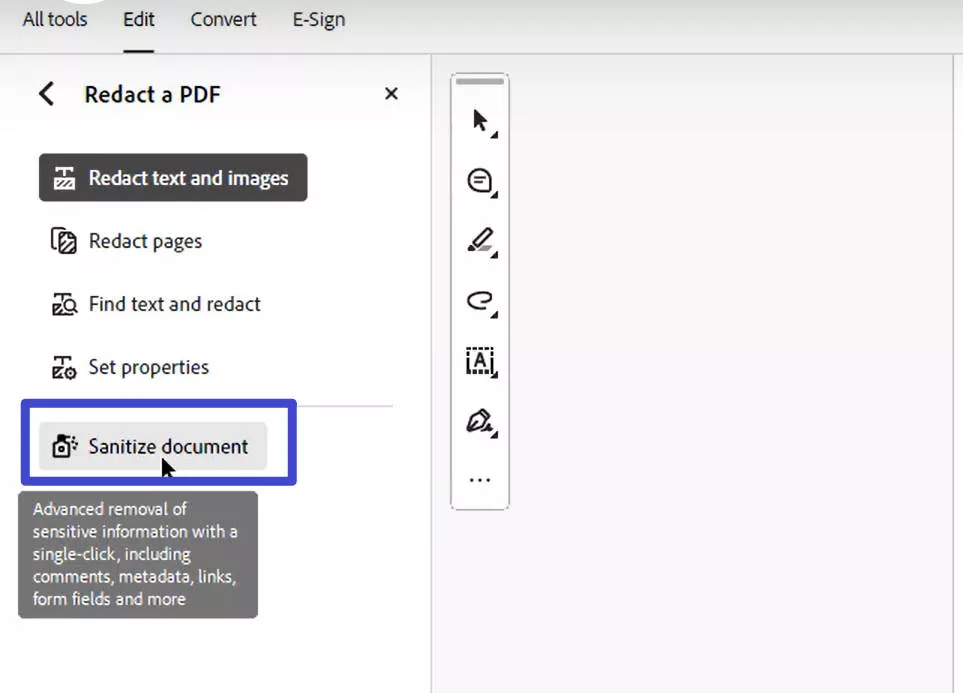
Step 3. A dialog box will appear. To proceed with removing all hidden information, select Remove all.
Step 4. After the sanitization process is complete, save the document to retain the changes. It's advisable to save it as a new file to preserve the original document.
3. Using Locklizard Writer
Another powerful tool to help users sanitize PDFs with encryption and DRM (Digital Right Management) feature is Locklizard Writer. It allows you to customize which hidden elements you would like to eliminate in its optimization settings. After removing, the sanitized PDF only displays page size, page rot, number of pages, and file size. Explore the tutorial below and eliminate information for security with a few steps:
Step 1. Download Locklizard Writer and right-click your desired PDF in the "File Explorer" of your device. Now, select the "Make Secure PDF" option from the revealing drop-down menu.
Step 2. In the appearing window, tick mark the "Optimize PDF" option and hit the cog icon beside it.
Step 3. From the given list of sanitization options, tick mark the ones you would like to apply. Lastly, press the "Publish" button to confirm the removals from the document.

4. Using PDFsam
PDFsam is an open-source platform that facilitates users with basic PDF editing and management features, including sanitization. Although it's not as advanced as many PDF editors, but delivers a sanitize PDF option through the "Secure" tab. With this platform, you can select the option to clean metadata and save a new sanitized version. Dive into the tutorial below and utilize this approach for basic sanitization needs:
Step 1. Commence PDFsam on the device and access the "Secure" tab from the toolbar at the top. Afterward, press the "Sanitize" button from the revealing options to "Secure."
Step 2. Go through the list of information involved in sanitization and press the "OK" button to finalize the changes.
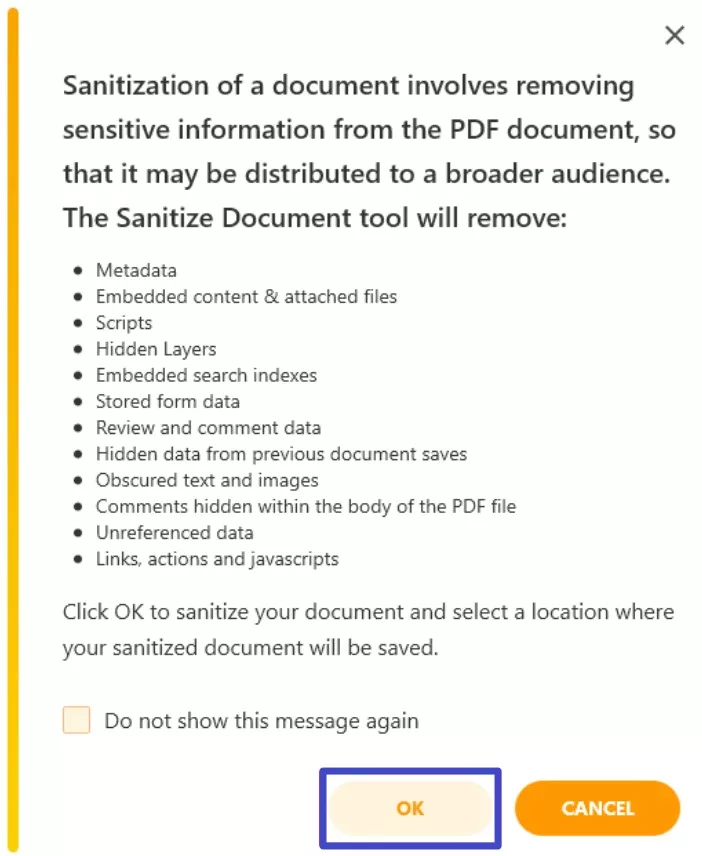
Windows • macOS • iOS • Android 100% secure
Part 3. FAQ About Sanitizing PDFs
1. What is the difference between cleaning and sanitizing PDFs?
One of the major differences that counts between cleaning and sanitizing PDFs lies in the depth of data removal. Cleaning involves deleting visible data, which may include removing some metadata but does not necessarily eliminate hidden data. On the contrary, sanitize PDF goes deeper, and it permanently eliminates all hidden data, including metadata and embedded contents.
2. Can PDF viruses spread?
Absolutely, PDF documents can carry viruses and malware, particularly when they contain embedded scripts, links, or any hidden attachments. However, to sanitize a PDF can help reduce this risk by removing hidden scripts and files.
3. How do I remove malware from a PDF?
First, scan the file with a reliable antivirus program to detect and remove hidden threats or malware from a PDF. After this, you can sanitize PDFs using a trustworthy tool like UPDF to eliminate any hidden suspicious metadata that could carry malware.
Conclusion
To protect your crucial information, it is important to sanitize PDFs because it guarantees that no hidden data remains accessible. However, people consider simply deleting or redacting content, which can still pose security risks if not properly removed.
Through sanitizing PDFs, you can prevent unauthorized access and comply with data protection standards. To take control over your document security, download UPDF with enhanced security functionalities.
Windows • macOS • iOS • Android 100% secure
 UPDF
UPDF
 UPDF for Windows
UPDF for Windows UPDF for Mac
UPDF for Mac UPDF for iPhone/iPad
UPDF for iPhone/iPad UPDF for Android
UPDF for Android UPDF AI Online
UPDF AI Online UPDF Sign
UPDF Sign Edit PDF
Edit PDF Annotate PDF
Annotate PDF Create PDF
Create PDF PDF Form
PDF Form Edit links
Edit links Convert PDF
Convert PDF OCR
OCR PDF to Word
PDF to Word PDF to Image
PDF to Image PDF to Excel
PDF to Excel Organize PDF
Organize PDF Merge PDF
Merge PDF Split PDF
Split PDF Crop PDF
Crop PDF Rotate PDF
Rotate PDF Protect PDF
Protect PDF Sign PDF
Sign PDF Redact PDF
Redact PDF Sanitize PDF
Sanitize PDF Remove Security
Remove Security Read PDF
Read PDF UPDF Cloud
UPDF Cloud Compress PDF
Compress PDF Print PDF
Print PDF Batch Process
Batch Process About UPDF AI
About UPDF AI UPDF AI Solutions
UPDF AI Solutions AI User Guide
AI User Guide FAQ about UPDF AI
FAQ about UPDF AI Summarize PDF
Summarize PDF Translate PDF
Translate PDF Chat with PDF
Chat with PDF Chat with AI
Chat with AI Chat with image
Chat with image PDF to Mind Map
PDF to Mind Map Explain PDF
Explain PDF Scholar Research
Scholar Research Paper Search
Paper Search AI Proofreader
AI Proofreader AI Writer
AI Writer AI Homework Helper
AI Homework Helper AI Quiz Generator
AI Quiz Generator AI Math Solver
AI Math Solver PDF to Word
PDF to Word PDF to Excel
PDF to Excel PDF to PowerPoint
PDF to PowerPoint User Guide
User Guide UPDF Tricks
UPDF Tricks FAQs
FAQs UPDF Reviews
UPDF Reviews Download Center
Download Center Blog
Blog Newsroom
Newsroom Tech Spec
Tech Spec Updates
Updates UPDF vs. Adobe Acrobat
UPDF vs. Adobe Acrobat UPDF vs. Foxit
UPDF vs. Foxit UPDF vs. PDF Expert
UPDF vs. PDF Expert

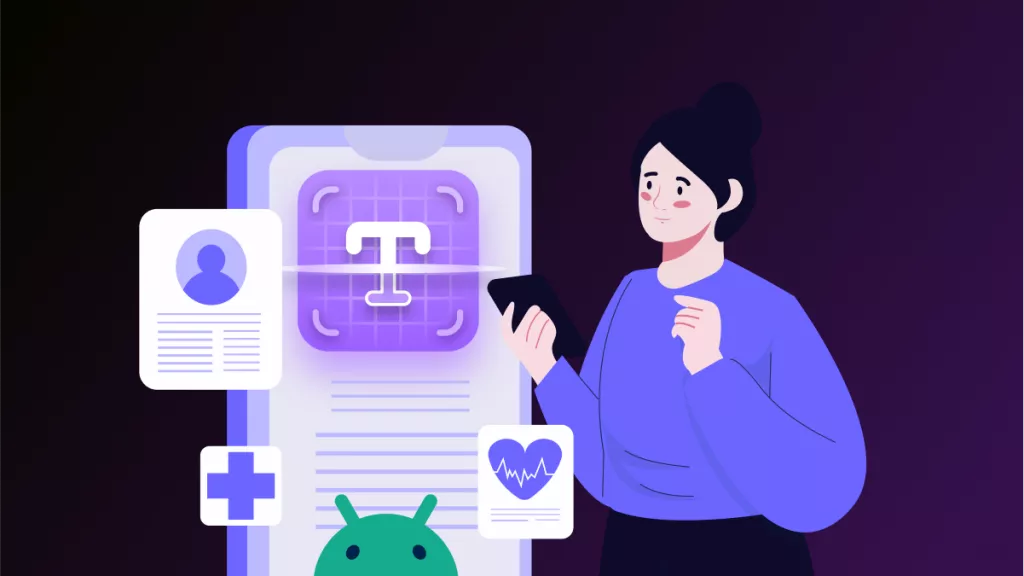
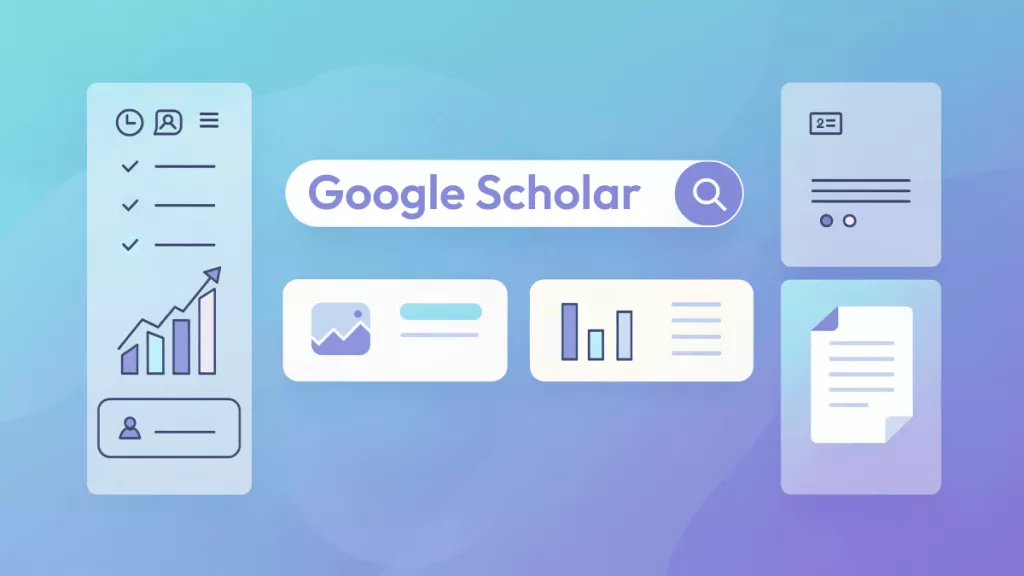




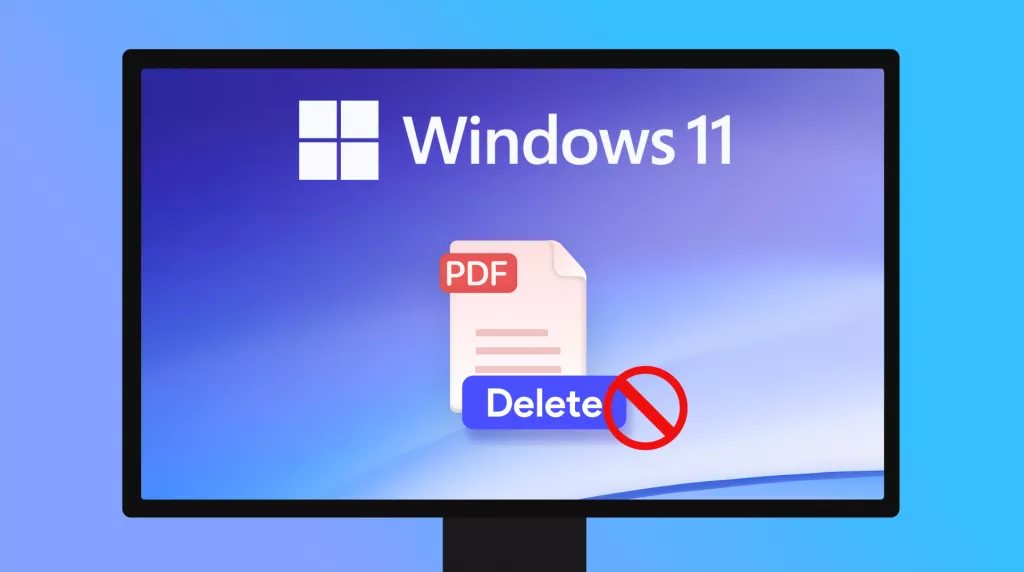
 Enola Davis
Enola Davis 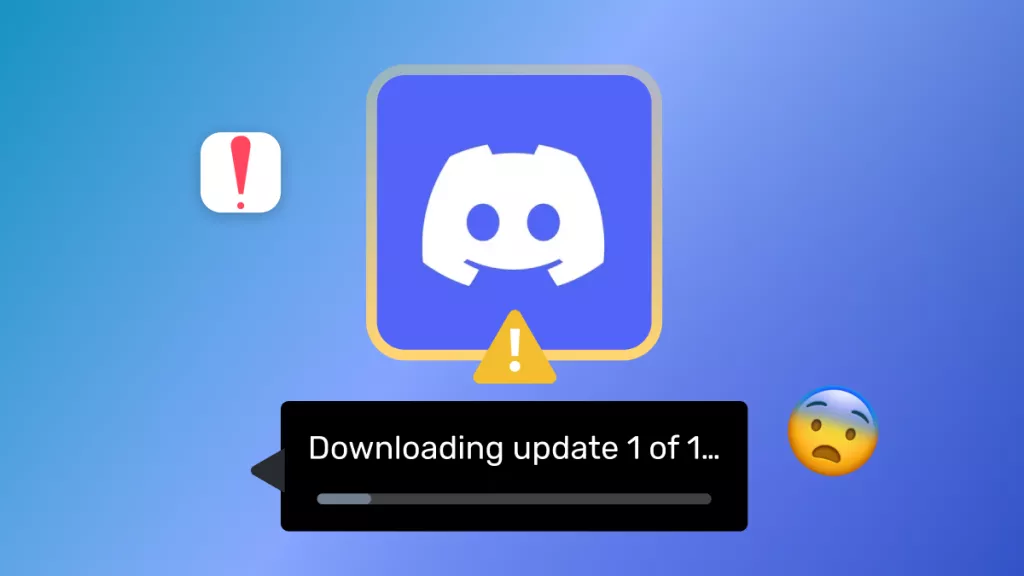
 Enya Moore
Enya Moore 
 Lizzy Lozano
Lizzy Lozano 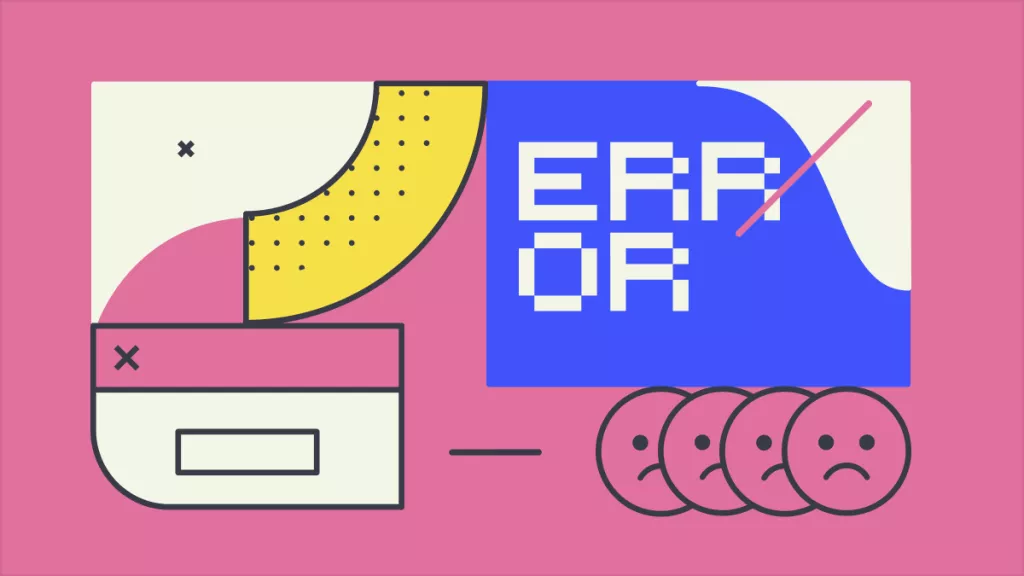
 Enid Brown
Enid Brown